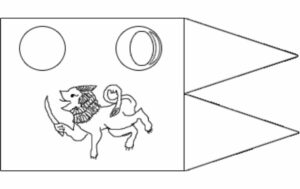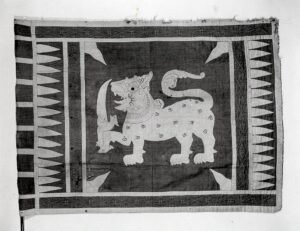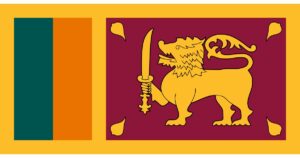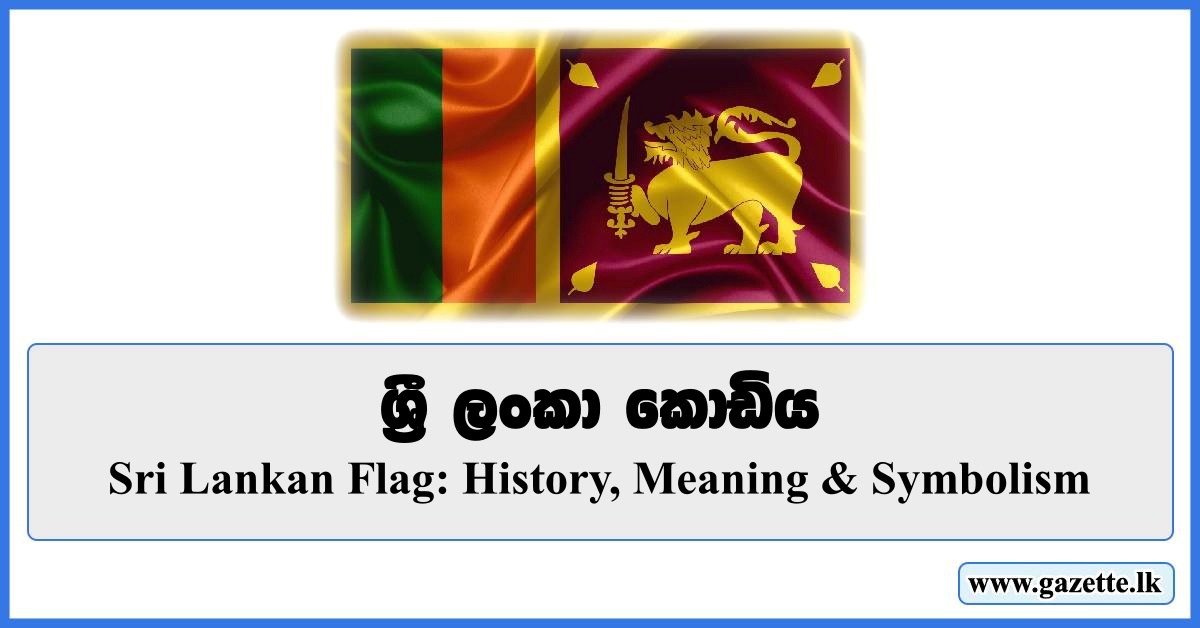The Lion Flag defines Sri Lanka as one of the world’s most historically profound national flags which carries deep symbolic value. The flag represents more than a national symbol because it demonstrates the heritage together with culture alongside unity and resilience of the nation. This study examines the historical development and configuration as well as the spiritual significance behind and individual aspects of the Sri Lankan flag.
Sri Lankan Flag, also known as the Lion Flag
Officially representing the Democratic Socialist Republic of Sri Lanka, the Sri Lankan flag is celebrated worldwide for its unique lion clutching a sword, it captures the country’s rich cultural legacy, historical values, and harmony among its several populations. Adopted formally in 1951 (with last changes in 1972), the flag is a potent symbol of freedom, pride, and unity.
Timeline of Sri Lankan Flag History (with Old Flags Explained)
c. 200 BCE – 1815: Ancient Royal Lion Flag
The historical Sri Lankan flag emerged during ancient royal times especially when Anuradhapura and Polonnaruwa kingdoms ruled. The flag contained a crimson background behind a golden lion holding a sword which symbolized royal power and Sinhalese bravery. History records King Dutugemunu and King Sri Wickrama Rajasinghe among the Kandyan monarchs who used this banner known as the Lion Flag of the Kandyan Kingdom. The symbol displayed strong political meaning since it indicated both royal might as well as national independence of the island.

Flag of Dutugamunu, Anuradhapura period
1815 – 1948: British Colonial Period
Sri Lanka (then Ceylon) lost her freedom when the British formally acquired the Kandyan Kingdom in 1815. Originally the native Lion Flag, the Union Jack became the official colony flag. This was a significant change since British imperial iconography replaced the old markers of local authority. Still, the lion emblem stayed a potent cultural symbol among the residents and a focal point for independence campaigns.

Flags of the Kingdom of Kandy
1948 – 1951: Lion Flag Revival
Ceylon needed a national flag once it was free of Britain in 1948. Once more taking front stage is the ancient Lion Flag, the official emblem featuring the golden lion on a crimson backdrop. But this version of the flag only reflected the Sinhalese majority, and demands to have other ethnic groups included more on the flag are mounting.

Flag of the Kingdom of Kotte’s flag, c. 1412–1597
1951 – 1972: Integration of Minority Representation
Two vertical stripes—one orange stripe for the Tamil community and one green stripe for the Muslim community—were added to the hoist side of the flag 1951. This shift represented a direction toward national unity and ethnic inclusiveness. The lion stayed the main character; four bo leaves were placed in the corners to symbolize Buddhist ideas: Metta (loving-kindness), Karuna (compassion), Mudita (joy), and Upektha (equanimity).

Flag of Kingdom of Sitawaka’s flag, c. 1521-1594
1972 – Present: Republic of Sri Lanka’s National Flag
The flag underwent its last official change upon the acceptance of the Republic Constitution in 1972. Though officially acknowledged as the National Flag of the Republic of Sri Lanka, the design stayed essentially the same as in 1951. It has been a dynamic emblem of Sri Lanka’s sovereignty, unity, and cultural variety ever since. Nowadays, the flag is a proud emblem flown across the island during national holidays, official government operations, and international events.
The Old Flag Custom Graphic from Sri Lanka

Standard of Sri Vikrama Rajasinha of Kandy, used as the Kingdom of Kandy’s flag, c. 1798–1815
King Sri Wickrama Rajasinghe used an earlier version that depicted a lion on a red field devoid of stripes. The flag became a real emblem of unity in 1951 when orange and green stripes representing the Tamil and Muslim communities were added.
Design and Colour Breakdown of the Sri Lankan Flag Element SymbolismHex Code Lion & Bo Leaves Buddhist virtues #FDB813 Bravery
Crimson Background Sinhalese background #A20000 Orange Stripe Tamil community #FF8000 Green Stripe Muslim community #007A3D
Unity of Gold Border among all people #FDB813
Symbolism of the flag of Sri Lanka

Key meanings broken out into component parts
- The Lion – Courage and Sinhalese background
- Sword – Independence and preparedness to protect the country
- Bo Leaves – Four Perfect Buddhist States:
- Metta – Sometimes known as loving kindness,
- Karuna – Compassion
- Mudita – Sometimes known as sympathetic delight
- Upektha – Equanimity,
- Background: Crimson, Sinhalese history and people
- Orange Stripe – Tamil society
- Green Stripe – Muslim community
- gold border – Unity, peace, and inclusivity
Approximate Color Codes (for web use):
| Element | Color | Hex Code |
|---|---|---|
| Lion & Bo Leaves | Gold | #FDB813 |
| Background (Lion Panel) | Crimson Red | #A20000 |
| Orange Stripe | Orange | #FF8000 |
| Green Stripe | Green | #007A3D |
| Border | Gold | #FDB813 |
When Do We Use the Sri Lankan Flag?
The Sri Lankan flag is used on many official, cultural, religious, and national occasions. Here’s a breakdown of when and where the Sri Lankan flag is typically used:
Official Government Use
- Flown daily at government buildings, parliament, and ministries
- Used during state ceremonies and official visits (e.g., when foreign dignitaries visit)
National Holidays & Celebrations
- Independence Day (February 4th) – prominently displayed at parades and ceremonies
- Vesak, Sinhala & Tamil New Year, and other national festivals
- National Heroes Day or memorial events
Educational Institutions
- Raised at schools during morning assemblies and flag-hoisting ceremonies
- Displayed during national education or cultural programs
Judicial and Legal Institutions
- Displayed in courts, police stations, and military headquarters
Personal or Civic Pride
- Displayed on homes, shops, and vehicles during national events or sports victories
- Flown at weddings, funerals of national figures, or community events
International Events
- Used in international sports (e.g., cricket, Olympics) to represent Sri Lanka
- Displayed at UN meetings, diplomatic missions, and embassies worldwide
Guidelines for Use
According to official protocol:
- The flag must never touch the ground
- It should be properly folded and stored when not in use
- It must be respected and never altered or misused for commercial purposes
Why is the Sri Lankan flag unique?
You can present Highlights in a Nutshell as either a chart or an infographic. The design showcases a lion wielding a sword, a rare sight on world flags.
It encompasses both ethnic and religious aspects. It embodies the historical legacy of the royal family.
typically reflects historical royal legacy.
“The Sri Lankan flag is a masterpiece in symbolic design. It combines modern unity and peace with thousands of years of history.” – Dr. Malathi de Alwis: Cultural Anthropologist
FAQs Regarding the Flag of Sri Lanka
When did the current flag become official?
- December 7, 1972
What does the lion represent?
- The Sinhalese people and bravery
What do the orange and green stripes stand for?
- Tamils and Muslims respectively
What do the four leaves mean?
- The Four Sublime States in Buddhism
Last Notes
The Sri Lankan flag is a living statement of Sri Lanka’s ideals, culture, and future, not only a banner. Understanding the components of the design helps us to respect the diversity and unity that define the nation rather than only honor the past.
Share these words with your neighborhood to raise knowledge of the pride and meaning underlying the Lion Flag!


